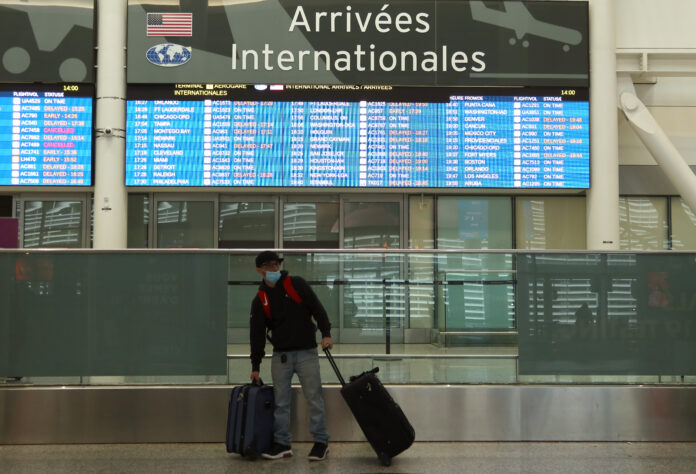As the highly transmissible BA.5 subvariant of Omicron continues to spread around the world, experts are urging Canadians who are travelling this summer to have health insurance, be up-to-date on their COVID-19 vaccinations, and to continue wearing masks in crowded spaces.
Dr. Don Vinh, an infectious diseases specialist at the McGill University Health Centre (MUHC), says there are several ways Canadian travellers can minimize the risk of catching the subvariant and getting severely ill.
He said travellers need to be familiar with the health system in the country they’re visiting and get health insurance to cover medical costs if they were to get hospitalized with COVID-19.
“If you were to get infected with BA.5 and fall sick in another country, how comfortable would you be to seek medical attention or be hospitalized?” Vinh said.
How the BA.5 subvariant is powering a new surge across Canada
Another way to protect oneself against Omicron and its subvariants, according to Vinh, is by being vaccinated with at least three doses.
“The last dose needs to be taken within the last three months to protect you from getting severe disease,” said Vinh.
In Canada, a fourth COVID-19 dose is already being offered as the seventh wave takes shape in many parts of the country.
READ MORE: Ontario expands 4th COVID vaccine doses to those aged 18 to 59 amid 7th wave
As of July 14 in Ontario, anyone aged 18 and older who had their first booster at least five months ago can book an appointment to get a fourth shot.
Other provinces and territories, like Quebec, Prince Edward Island, Nunavut and Yukon, have also opened up eligibility for second boosters — or a fourth dose — to anyone over the ages of 18, provided their last shot was at least three months prior.
Vinh also recommended that Canadians continue to wear masks while travelling, especially in crowded spaces.
“You can acquire BA.5 here locally. You don’t have to travel around the world to acquire it, but you don’t have to acquire it and unnecessarily get sick, so there are measures to prevent that,” said Vinh.
White House to prioritize boosters, testing for Omicron BA.5 subvariant
Dr. Earl Rubin, director of the infectious disease division of the Montreal Children’s Hospital, shared similar recommendations but added if a traveller is returning to Canada and has symptoms, they should not be out and about circulating the virus in the community.
Trending Stories
Ivana Trump, 1st wife of former U.S. president Donald Trump, dead at 73
As Hockey Canada re-opens alleged sex assault probe, here’s what 2018 players say so far
“If there is an absolute, essential need to go out, make sure that you wear a mask and keep a two-meter distance,” said Rubin. “Avoid contact with vulnerable people.”
“I think that this is very important because public health is not tracking people (with COVID) like they did before, not enforcing (mandates). So we have to rely on people’s own sense of what is right and wrong,” he added.
READ MORE: New COVID-19 Omicron mutation sparks concern in India and beyond
The federal government announced plans Thursday to bring back random testing of travellers at Canada’s four main airports for COVID-19 next week, but intends to move the actual swabbing off-site.
Rubin said he believes random testing is now being put in place to detect any new variants that may enter the country.
“I think travel is a significant issue if there is a variant in the destination to where you’re going that we don’t have here,” he said.
For Vinh, this new testing strategy is just a “symbolic gesture to remind people that the pandemic is not over.”
“I think if perhaps the federal government has policies that remind us that the pandemic is not over, then from a federal perspective, it’s trying to protect or at least symbolically protect Canadians,” he said.
COVID-19: Canada to resume random mandatory testing at airports
On July 12, the World Health Organization (WHO) warned that COVID-19 cases are rising across the world as BA.5 spreads at a “very intense level.”
The spread of BA.5, which is now the dominant version of the virus globally, is of concern because it has a growth advantage over other sub-lineages of Omicron, said WHO COVID-19 technical lead Dr. Maria Van Kerkhove at Tuesday’s briefing.
“The virus is spreading at a very intense level at a global level and our ability to detect cases has reduced since the surveillance strategies have changed,” she told reporters.
The WHO has seen a substantial increase in reports of BA.5 cases over the last four weeks alone, Van Kerkhove said, adding that the trend is expected to continue around the world.
READ MORE: 17M Canadians got Omicron in 5 months, new federal report says
Canada’s Public Health Agency projects more cases in the coming months due to increases in the BA.4 and BA.5 sub-lineages of Omicron, according to its June 30 statement.
Some sobering figures from Canada’s COVID-19 Immunity Task Force released last week showed how quickly the Omicron variant of COVID-19 and its subvariants spread across the country at the end of 2021 and the first few months of this year.
An analysis of data from blood testing suggested that 17 million Canadians were infected in only five months, between December 2021 and May 2022.
– with files from Global News’ Saba Aziz and The Canadian Press
© 2022 Global News, a division of Corus Entertainment Inc.



